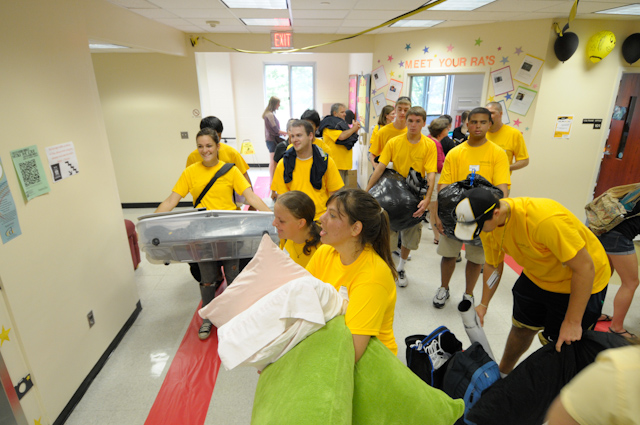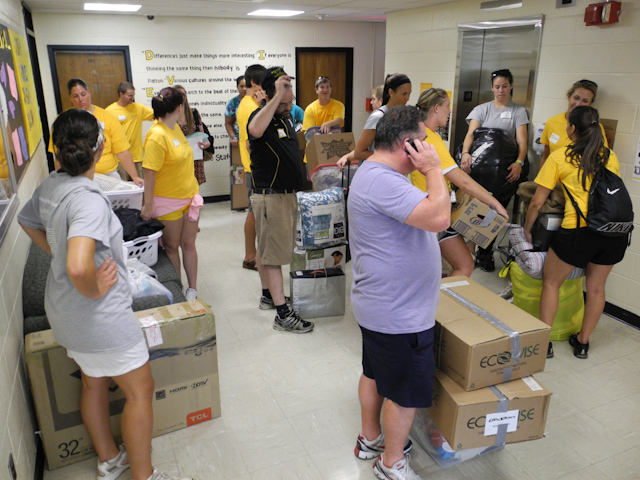On Driving and Fuel Economy
From the it's not what you drive, but how you drive it department.
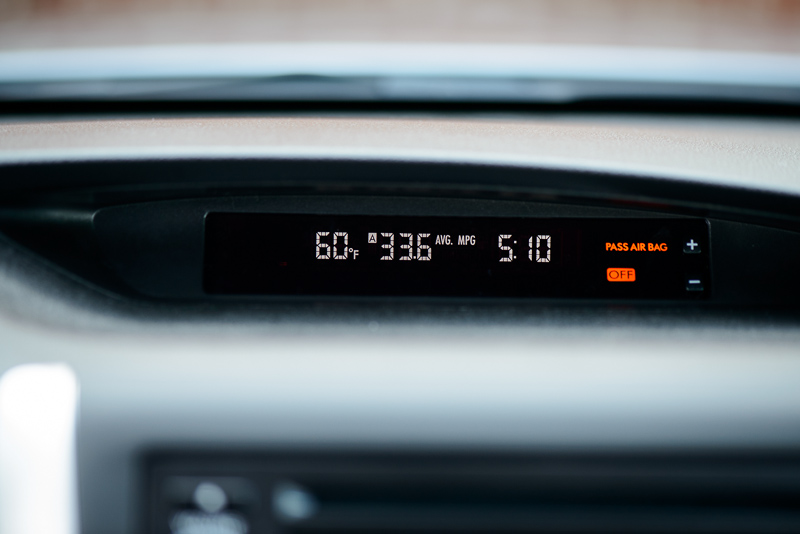
Yes, that's 33.6MPG from a car that's only rated for 25MPG on the highway. The reading checks out with some good old fashioned math. In town I can usually squeeze 24-26MPG out of the engine if I keep the revs down below 2,000 RPM. Now that I'm past the 1,000 mile break in period I can really stand on the throttle and watch the gas milage tank.
I'm glad I didn't go the econobox route. The WRX is much more fun to drive and this has changed driving for me entirely. Now it's more of a recreational activity instead of a means of conveyance. I've actually been driving less since I made the new car purchase too. Strange, I know. I guess you can put that down in the eco-friendly column as well. I've been using more public transit and walking in town more to save wear and tear on the car, not to mention parking on campus is mostly a demolition derby.
These days I mostly just drive on the weekends for longer distance trips, even then I'm taking the longer less busy route as it's more fun. Having a car that's more focused on being a driver's car instead of just a means of transportation has really changed my habits, for the better I think. I'm all for the environment but a Prius or an underpowered econobox is a horrible choice for anyone who is a recreational driver or a car person. I think the the trade off of driving less is a fair one. That is until the Tesla Model S comes down in price.
To quote Jeremy Clarkson: "much better don´t change your car, change your driving style."
Comet C/2011 L4 PANSTARRS
There's been a lot of hype surrounding comet PANSTARRS. While it will be visible with the naked eye in the early twilight hours it will not as spectacular as Hale-Bopp, Hyakutake or McNaught. That shouldn't stop you from going out for a look, just don't be surprised when it's not a jaw dropping sight. A pair of binoculars will be useful for locating it in the evening twilight. However, you'll need to be careful as it will be fairly close to the sun before March 12th. It's been predicted to hang out around magnitude 2 or so which is about the same brightness as the stars in the Big Dipper or Orion's belt. If it were above the horizon longer after sunset this would probably be a good sight for most people, however the glare of twilight will wash it out substantially.
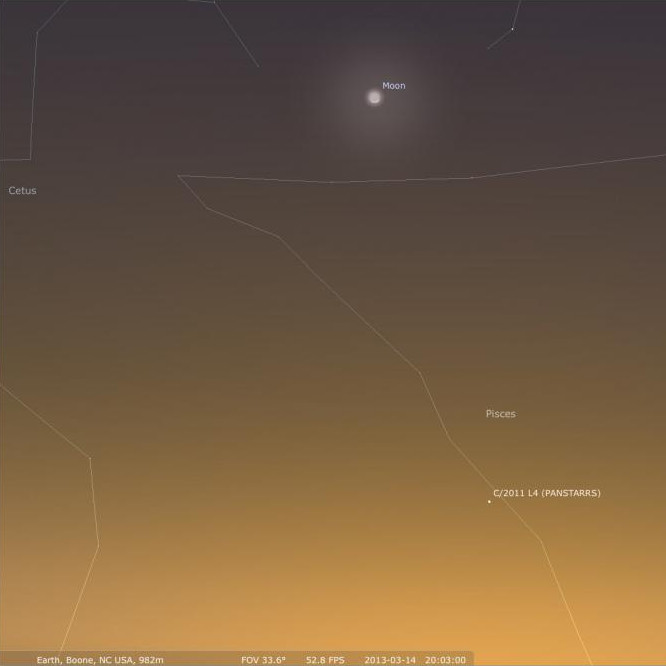 PANSTARRS on March 14th from a middle northern latitude.
PANSTARRS on March 14th from a middle northern latitude.
From about March 12th to 14th PANSTARRS will have a nice pairing with the thing waxing crescent moon. This will make it easier to find and create an good photo op. A normal to semi-telephoto lens will be useful, something in the 85mm + range I'd guess, for trying to capture PANSTARRS. Don't be afraid of a higher ISO either. Second magnitude isn't terribly bright and ISO 1600+ will let you take a short enough exposure that the Earth's rotation shouldn't blur things up too badly. You'll also need a very clear view of the western horizon. At most comet PANSTARRS will only get around 10º above the horizon. That's only about a fist width held out at arms length. Below are a series of screen captures from Stellarium showing the comet's progression over the next few days. You can click to enlarge.
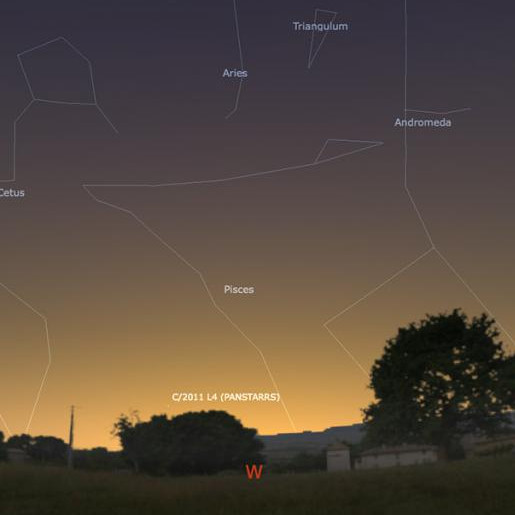 Looking west on March 10th 2013 at about 7:55 PM EDT (6:55 PM EST). Not very high in the sky and hard to spot.
Looking west on March 10th 2013 at about 7:55 PM EDT (6:55 PM EST). Not very high in the sky and hard to spot.
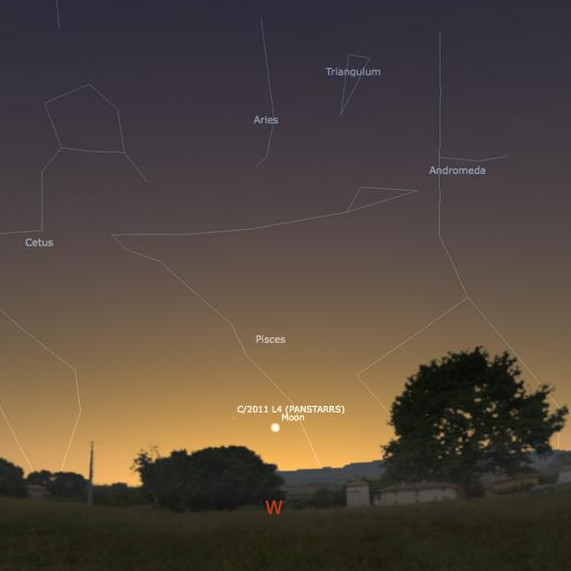 Looking west on March 12th 2013 at about 7:55 PM EDT (6:55 PM EST). A little better, still not great.
Looking west on March 12th 2013 at about 7:55 PM EDT (6:55 PM EST). A little better, still not great.
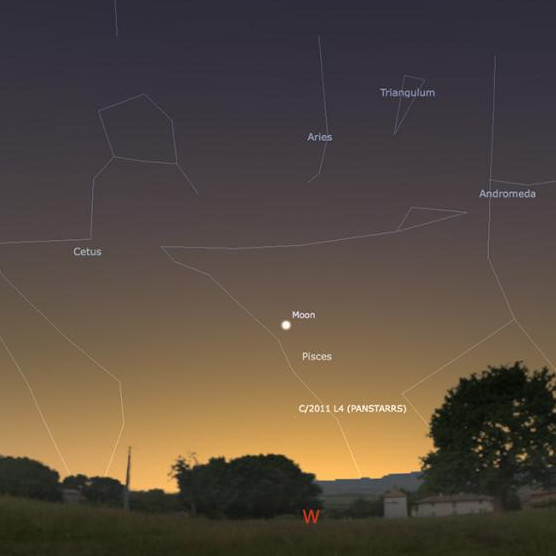 Looking west on March 13th 2013 at about 7:55 PM EDT (6:55 PM EST). One of the best nights.
Looking west on March 13th 2013 at about 7:55 PM EDT (6:55 PM EST). One of the best nights.
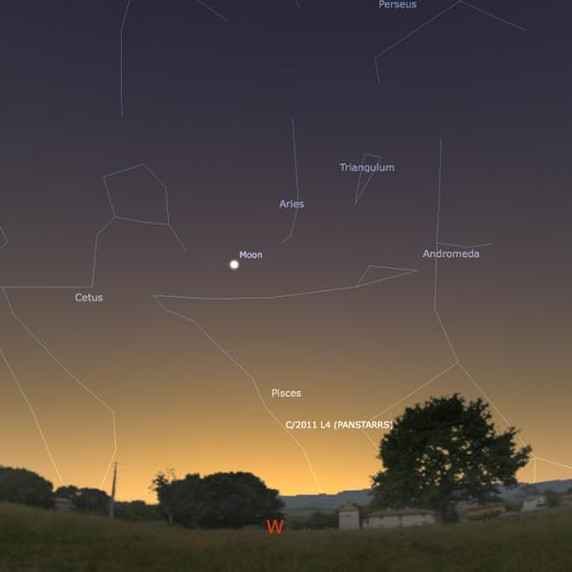 Looking west on March 14th 2013 at about 7:55 PM EDT (6:55 PM EST). Probably the second best night to catch PANSTARRS.
Looking west on March 14th 2013 at about 7:55 PM EDT (6:55 PM EST). Probably the second best night to catch PANSTARRS.
Again, I wouldn't let any of this stop you from going out and checking it out. Naked eye comets are rare and even small ones are fun to see. Consider it practice for comet ISON later this year. If it holds up to the hype it should be nothing short of spectacular. However, comets are very hard to predict so at this point ISON could do anything between now and December.
2012 is so last year ...
2012 is behind us. It was a busy year, it barely seemed like it was there. This past year was the first full year of my life I wasn't enrolled in school or taking classes for anything. I'm definitely not ready to settle on a career for thirty years and retire and I might be back in school before long. Sitting still this long isn't something I'm terribly good at.
A few momentous things happened. Thankfully the weather held out long enough for me to view and capture the transit of Venus on June 6th. I was considering traveling to somewhere with a more stable climate but that didn't pan out. This resulted in one of my favorite photos of 2012. I'm grateful I was able to see the transit in person as there won't be another one until long after I've passed away.
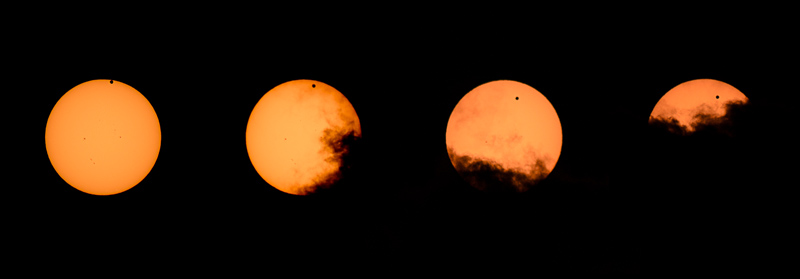
In August I was able to visit Kennedy Space Center (thanks for the ride, Rob) via the NASASocial program. Even though the RBSP's (now Van Allen Probes) launch was postponed a few times it was still an amazing experience. I'm itching to get back again, although not in summer next time. I'm not sure how people actually live in Florida. That exceptionally hot, humid, and just plain disgustingly sticky feeling you call a climate is enough to write off the state for residency in my book. Seriously, it was 86ºF at 2:00 am. What's up with that? Maybe it'd be tolerable between November and March. My favorite photo was a sunrise panorama of the KSC press area featuring the VAB. A consolation prize for not actually seeing a launch.
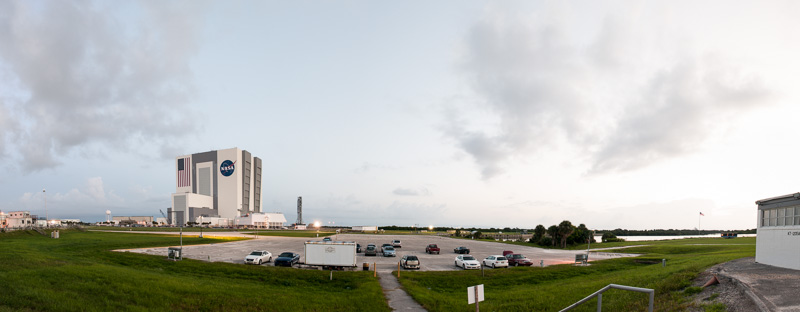
Not to mention Megan and I celebrated our second wedding anniversary. We're still doing well. I've really enjoyed having time off the last couple of weeks to spend with her. Not having to deal with eight hours in the office (sorry if you've been trying to get a hold of me for work related stuff, I've been ignoring my work email) has really helped me relax. Even she noticed a difference in my mood.
In 2013 I'm wanting buckle down and focus on a core set of skills. I'm spreading everything too thin and not really making progress in any one direction. In the immortal words of Ron Swanson: "never half ass two things, whole ass one thing." Humans are bad at multitasking and I'm no exception.
Stand and Deliver
With the office move at work I took the opportunity to try out this standing desk thing. Since the budget for new furniture in the office is nonexistent I ended up fabricating my own desk with some cinder blocks and an old workbench I rescued from surplus. The result is a little shaky, but it works.
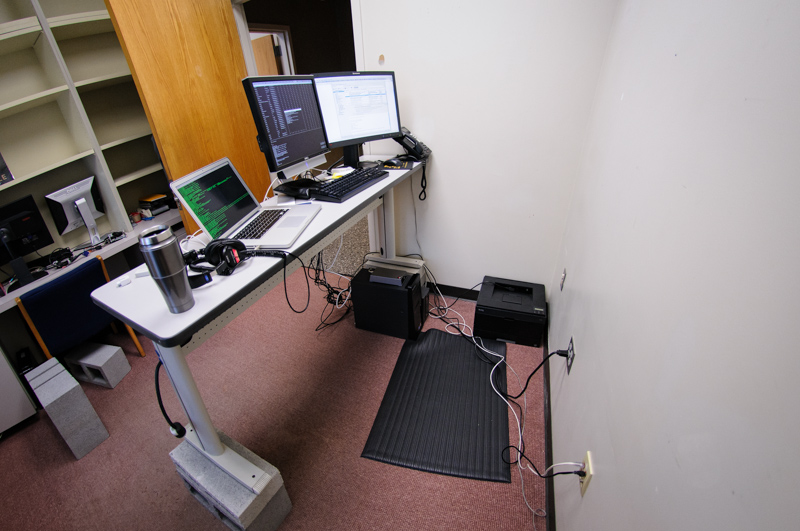
I've been standing for three days so far. It's been challenging, a lot like starting a workout routine. My lower back seems to feel better but it's definitely coming the cost of my feet, hips and knees. I think that's a sign that I need to lose more weight. So far so good though. I might try to find a high rise chair or stool to use part of the time too. The biggest difference I've noticed is in my ability to focus. I've really been chewing through my to-do list and I seem to daydream a lot less. Not sure if that's really good or bad in the long run, a lot of my better ideas have come from letting my mind drift off.
Between the new desk and the Das Keyboard my work environment is nearing tolerability.
EDIT: Please excuse the mess of wires in the photo. I haven't had time to do my usual wire management yet.
On Spacecraft, Milestones, and Progress
Curiosity’s findings stole the show on Monday and from a scientific standpoint they are rather tantalizing. Mars leaves a great deal of mystery to be uncovered. However, I believe the more stirring and historically interesting find came from another small nuclear powered probe launched thirty some years ago.
Voyager 1 is currently the furthest manmade object that has ever been sent out from Earth and the Voyager program as a whole is the longest running space exploration mission humans have ever put forth. It was reported a few years back that Voyager 1 was believed to be closing in on the edge of our solar system. Although the readings from the probe's still functioning sensors differed from the expected. This sent scientists back to the models to try and figure out what was going on. After some time to ponder and some new data coming in over the last few months it appears that the Voyager 1 craft is indeed nearing the edge of the solar system. I won’t weight you down with the specifics; the official NASA release on the data is very in depth for those interested.
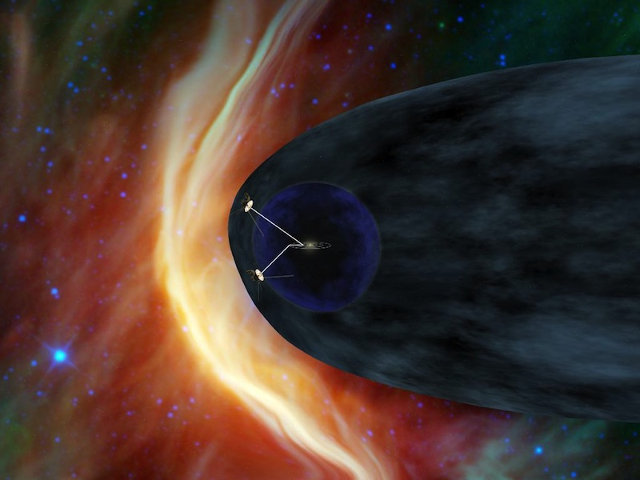 Voyager 1 and 2 on their way out of the solar system. Image source:NASA
Voyager 1 and 2 on their way out of the solar system. Image source:NASA
The significant thing here is the fact that a piece of human technology is on the cusp of interstellar space. After traversing millions of miles, making close encounters with the outer planets, diligently radioing back a wealth of data the outer most reaches of our tiny, backwater solar system Voyager 1 is about the break loose and continue on a journey to the stars.
Think about that for a minute. Just sit back and take it all in.
It’s easy to lose track of the significance of such an accomplishment in an era where humans living among the stars is common in our fiction. Considering the fact that the first airplanes were put into service just over a century ago and the first orbital flights of unmanned satellites happened just over sixty years ago this is an astonishing accomplishment. In age where GPS and nearly instantaneous worldwide communication are available to nearly everyone it’s hard to imagine just how far we’ve come in such a short time. A century is just the blink of an eye on the cosmic scale, barely enough time for a few generations of even our own species to come and go. In that same time we’ve survived numerous threats to our very survival. Most of them caused by own our technology and ambition, the very same thing that has sent humans and our robotic counterparts to other worlds. Yet, here we are, about to leave the boundaries of our cosmic backyard.
Voyager 1 is the forerunner. The first step in what I hope will be a continued age of discovery and exploration. Once it crosses the heliopause we can say humanity has left its mark not only on the Earth or the solar system, but also on the galaxy. We’ve ridden our proverbial bicycles across the street into unknown territory. Truly a testament to our own potential, to what can be accomplished by a few simple primates working hard on a small greenish blue planet in the nondescript corner of the universe.
RBSP NASA Social
After applying to a few NASA Socials this year I was finally accepted to the Radiation Belt Storm Probe launch. I’m pretty excited about the whole thing and actually looking forward to the drive down to Kennedy Space Center. The launch itself is taking place on August 23rd at 4:08am. I’m not terribly fond of the launch time although it should still be dark at that time of morning. I hear night launches are spectacular and that should more than make up for the early wake up time.
The mission will focus on studying the Earth’s Van Allen Radiation Belts and how the sun influences these phenomena. I’m hoping to learn a great deal more about the mission during the briefings at KSC this week. Solar science wasn’t really my research focus in undergrad or grad school so I don’t know a great deal about it. Understanding the solar weather and the radiation belt environment is essential to future satellite and spacecraft design.
I’ll be posting updates on Twitter and Google Plus, maybe on Facebook but the first two get priority. Hopefully the blog will get some #RBSP love too.
Photographing the Sun
Please use caution when viewing the sun! Viewing the sun without proper protection could damage your imaging equipment or vision! Sunglasses and standard ND filters are NOT sufficient protection!
This week has been a busy one in terms of solar activity with sunspot AR1476 taking center stage. It's fairly large as sunspots go at roughly 7.5 times the size of the Earth and actually visible to the unaided eye with proper viewing protection. Any set of eclipse viewing glasses will allow you to safely view the spot. I recommend the AWB glasses from Woodland Hills Telescopes. The proceeds from the glasses go towards Astronomers Without Borders. Surprisingly enough the spot hasn't sent any massive flares or ejection our way as of this post.
Photographing solar phenomena isn't quite as hard as it seems. Using my usual Induro BHD1 ball head, a sturdy tripod, the Orion Short Tube 80, glass solar filter, and Nikon D7000 with appropriate adapters I managed to capture the shot below. The trickiest part is actually aiming the scope at the sun. The best way I've found so far is to watch the telescope's shadow and adjust its positioning until the shadow appears its smallest. Sort of like viewing a sun dial at noon. Of course none of this is a problem with higher end go-to models.
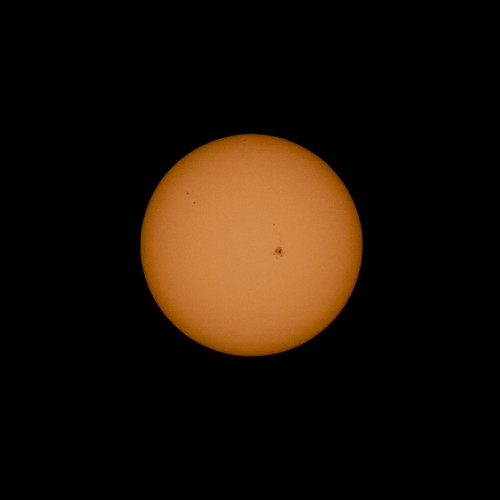 Sunspot AR1476 - Nikon D7000 - ISO 400 1/500, Orion ST80
Sunspot AR1476 - Nikon D7000 - ISO 400 1/500, Orion ST80
Yes that photo really was taken in the middle of the day. Good solar filters knock out around 99% of the incoming light, hence the black sky. The orange tint is due to the filter glass, the sun is actually closer to white in color. I have some Baader solar film on order that will hopefully be here later this week. Apparently it produces a less color shifted image. It's hard to get ahold of right now since most of the solar filter equipment is on back order due to the approaching transit of Venus.
Even if you're telescope-less a set of eclipse glasses are a cheap and easy way to checkout our nearest star. They'll be especially useful this June for the transit. Which, by the way, is the last one for the 21st century. You won't get another shot.
Venus and Jupiter for March 2012
If the skies are clear this Wednesday be sure to look towards the west right after sunset. You will see two bright stars about 20 degrees or so above the horizon. Those are in fact not stars but Venus and Jupiter. They should be closest together in our night sky on the evening of March 14 and March 15, 2012. At that time you can block them out with two fingers held out at about arm's length.
These are relatively common events happening every thirteen months or so. So, if you end up missing it due to cloud cover don't panic. Given their bright apparent magnitude the two planets will be visible even from Boone's heavily light polluted skies.
The image below is a screen from a free open source program called Stellarium which is available for Windows, Mac and Linux. It shows the western sky at 20:30 (8:30 PM) on March 14 from Boone. If you find Venus and Jupiter (they'll be hard to miss) you should be able to easily find the Pleiades in Taurus and M42 in Orion. Although they'll be harder to spot if you live downtown.
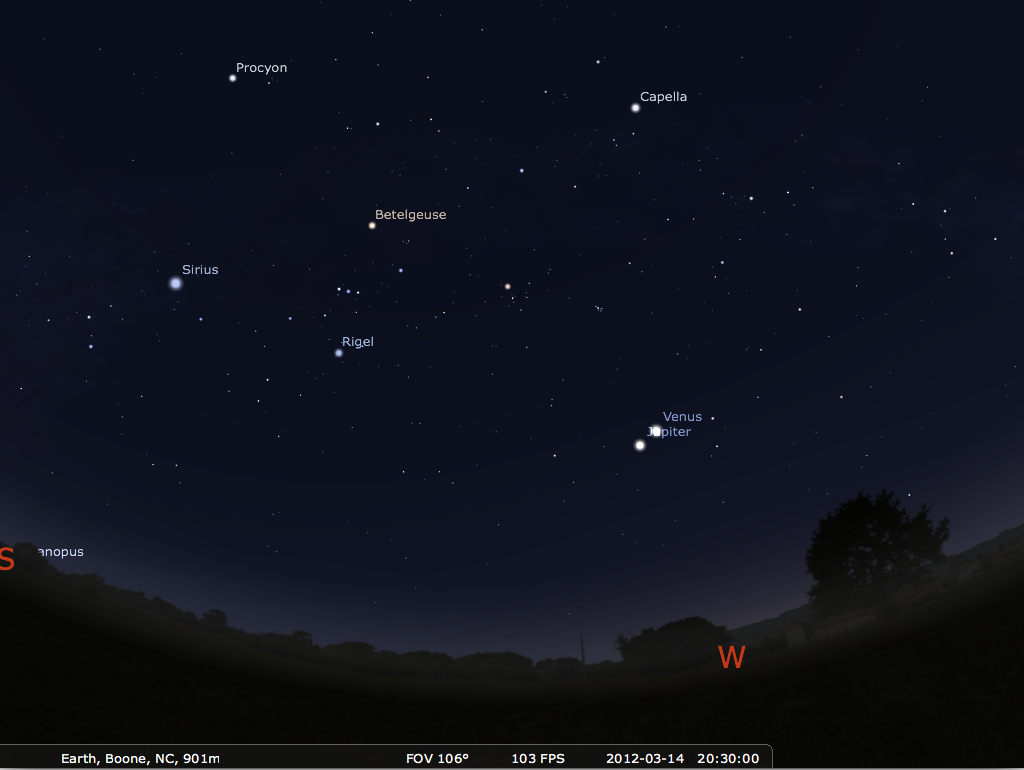
The Sagan Series
Recently I discovered a series of videos on YouTube done in tribute to the late astronomer Carl Sagan by Reid Gower. The production quality is quite good. So far my favorite is the latest video The Gift of Apollo:
Each video is around five minutes in length, give or take. Head over to The Sagan Series site for the complete playlist. Right now I think we need nothing more than some solid advocacy for science and critical thinking.
AppState Move In 2011
This year's move in weekend was my eighth since I started at App back in 2003. Well, technically the seventh if you don't count '03 since I wasn't a student employee yet. I used to hate it back then but now that I'm a certified desk jockey I actually enjoy roaming the dorms and setting up machines for folks. A lot of parents had positive comments about the move in process and many nice things to say about the volunteers. Other than a few elevator issues in the west campus dorms everything seemed to go smoothly. The photos attached are the lines of volunteers, students and parents waiting for said elevators to return to the ground floor.
Oh, I definitely managed to recruite a few new players for AppGaming's Minecraft server. Looking forward to some epic builds on this year's map.
Hopefully this year's freshmen aren't pinched too hard by the budget cuts.
